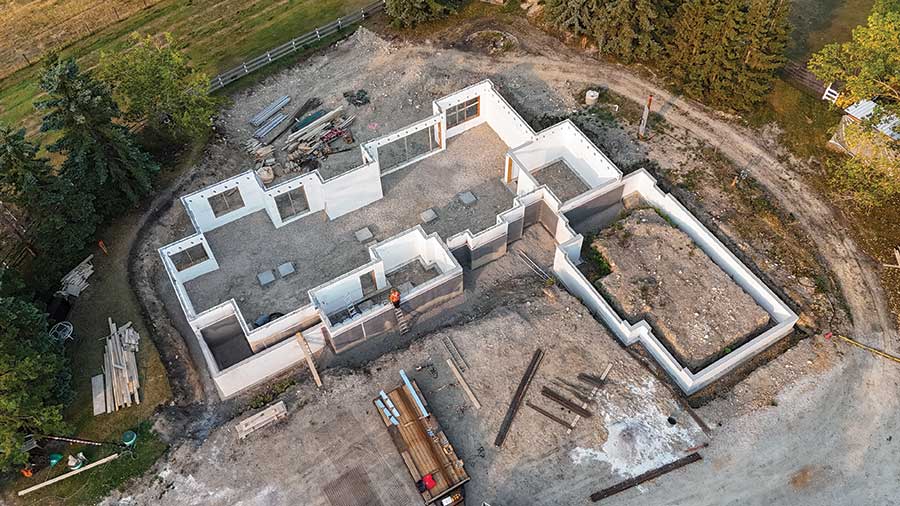By Blaine Dejax
Photo courtesy of the Insulating Concrete Forms Manufacturers Association
Overlooking the Bow River near Cochrane, Alberta, sits a 7,000-square-foot ICF home. This home boasts two stories of ICF, a below-grade safe room, an interior cold room, 46 corners or tees, and two 16-foot-wide patio doors. With 150 ICFVL6 floor hangars supporting the floor system, one could park seven fully loaded tractor trailers on the main floor before the ledgers began to sink.
Was ICF construction really the best choice for this home?
As one can imagine, some fairly extensive engineering went into a project of this scope. Buildings of this size usually require project-specific engineering to ensure compliance with codes and safety for occupants. This comes with a challenge for many engineers, who do not always have extensive experience with ICF. When this is the case, the age-old rule must be followed: “Keep It Simple, Stupid.”
The lintels over the patio doors on this particular building were designed with the same 6-inch core SuperForm ICF as the rest of the building. These were originally engineered with so much rebar that even a small-aggregate concrete mix would have never been able to properly fill or consolidate in the header. There would be no way to fit a pencil vibrator into it, giving consideration to the reinforcement, floor hangers, and webbing. This meant the original design was not an option.
On this site, with the engineer’s approval, the contractor opted to use single 25-meter rebars with 10-meter stirrups, greatly reducing the number of obstructions while maintaining the integrity of the concrete beam. Moving up in rebar size and down in bar quantity is an excellent way to reduce obstructions and simplify the pour. However, an even better option was available for a case like this. A simple 24-inch LVL beam could have been put in place. This would have doubled as the floor ledger in this location, and would have come at a fraction of the labor and cost involved with the original design.
Builders, engineers, and designers must ask this question: “Is ICF really the best product for this particular situation?” In many (most?) cases, the answer ought to be a resounding “Yes.” But in some cases, an engineered wood header will be an option that comes with a lower purchase or labor cost. It will likely also come with a lower potential for incorrect installation or product failure. Other such examples of places it may or may not be beneficial to use ICF include cantilevers, overhangs, and garage door lintels. Promoting ICF in situations where it is not truly beneficial to the client is detrimental to the industry as a whole.
Blaine Dejax
Blaine Dejax is a contractor and ICF builder serving Central Alberta. He has been involved with the production, design, distribution, and installation of SuperForm Insulated Concrete Forms for more than 10 years.









Help me to understand why it is not beneficial to use ICF for a garage door header? If the header is designed correctly and possibly use some type of fiber reinforcement in the concrete (I.e. Helix reinforcement), it will lessen the amount of rebar needed, decrease construction timelines, and lessen the margin of error. I am currently designing a large residential project with ICF using ICF headers and cantilevered walls all designed and engineered properly with the use of fiber reinforcement. Granted, it may not be the most cost effective way, but it can be done and done properly.